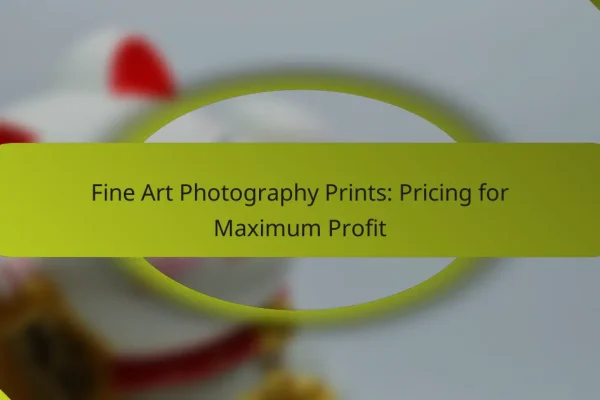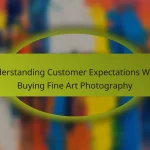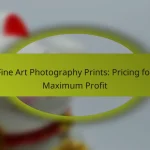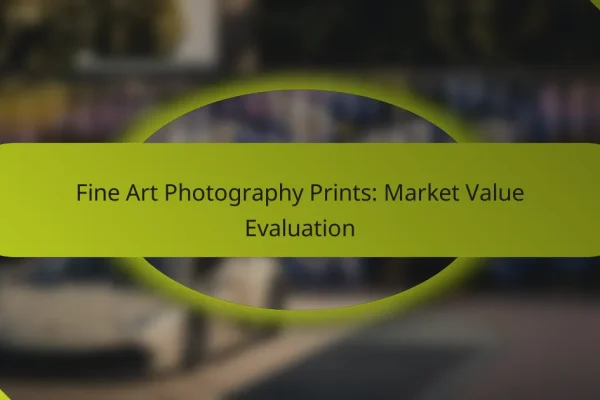What are effective pricing strategies for fine art prints?
Effective pricing strategies for fine art prints help artists and galleries determine the best price points to maximize sales while reflecting the value of the artwork. Key strategies include cost-plus pricing, value-based pricing, dynamic pricing, tiered pricing, and psychological pricing.
Cost-plus pricing
Cost-plus pricing involves calculating the total cost of producing a fine art print and adding a markup for profit. This method ensures that all expenses, including materials, labor, and overhead, are covered while providing a predictable profit margin.
For example, if the total cost to produce a print is $50 and the desired markup is 50%, the final price would be $75. This straightforward approach is easy to implement but may not always reflect the true market value of the artwork.
Value-based pricing
Value-based pricing sets prices based on the perceived value of the artwork to the customer rather than the cost of production. This strategy requires understanding the target audience and what they are willing to pay for a piece.
For instance, if a print is associated with a well-known artist or a unique style, it may command a higher price despite lower production costs. Artists should consider factors like exclusivity, emotional connection, and market demand when using this approach.
Dynamic pricing
Dynamic pricing adjusts prices based on current market conditions, demand fluctuations, or customer behavior. This strategy allows artists to capitalize on high-demand periods or special events, such as art fairs or exhibitions.
For example, an artist might increase prices during a gallery opening when interest is high and lower them during off-peak times. However, this approach requires careful monitoring of market trends and customer responses to avoid alienating potential buyers.
Tiered pricing
Tiered pricing offers different price levels for various versions or sizes of fine art prints. This strategy caters to a broader audience by providing options that suit different budgets and preferences.
For instance, an artist might sell a limited edition print at a premium price while offering open edition prints at a lower cost. This approach can increase overall sales and attract a diverse customer base while maintaining the perceived value of exclusive pieces.
Psychological pricing
Psychological pricing leverages consumer behavior insights to set prices that appear more attractive. Common techniques include pricing items just below a round number, such as $99 instead of $100, to create a perception of a better deal.
Additionally, using charm pricing, where prices end in .99, can encourage purchases. Artists should be mindful of how pricing strategies impact customer perceptions and adjust accordingly to enhance sales without compromising value.
How do market trends affect pricing in major cities?
Market trends significantly influence pricing for fine art prints in major cities by dictating demand, competition, and consumer preferences. Artists and galleries must stay attuned to these trends to set competitive prices that reflect the current market landscape.
Demand fluctuations
Demand for fine art prints can vary greatly based on economic conditions, seasonal trends, and cultural events. For instance, during art fairs or exhibitions, demand may spike, allowing for higher pricing. Conversely, in economic downturns, demand may drop, necessitating price adjustments to attract buyers.
Monitoring local events and economic indicators can help artists anticipate demand shifts. Keeping an eye on social media trends and art community discussions can also provide insights into emerging interests.
Competition analysis
Understanding the competitive landscape is crucial for pricing fine art prints. Major cities often have a diverse range of artists and galleries, each with unique offerings. Analyzing competitors’ pricing strategies can help determine where to position your work within the market.
Consider conducting a comparative analysis of similar prints in your area. This can involve visiting galleries, browsing online marketplaces, and reviewing auction results to gauge average price points and identify potential pricing opportunities.
Consumer preferences
Consumer preferences play a vital role in shaping pricing strategies for fine art prints. Factors such as style, medium, and artist reputation can influence what buyers are willing to pay. Understanding these preferences can guide pricing decisions and marketing strategies.
Engaging with potential buyers through surveys or social media can provide valuable feedback on what they value in art. Tailoring your offerings to meet these preferences can enhance sales and justify pricing, especially in competitive urban markets.
What factors should be considered in pricing fine art prints?
When pricing fine art prints, several key factors must be taken into account to ensure the price reflects both the value of the artwork and the costs involved. These factors include production costs, the artist’s reputation, print quality, and market positioning.
Production costs
Production costs encompass all expenses related to creating the fine art prints, including materials, labor, and overhead. For example, high-quality paper, ink, and printing technology can significantly increase costs. Artists should calculate these expenses to determine a baseline price that covers their investment.
Additionally, consider the scale of production. Limited editions may have higher per-unit costs due to the exclusivity and craftsmanship involved, while larger runs might reduce costs but could affect perceived value.
Artist reputation
The reputation of the artist plays a crucial role in pricing fine art prints. Established artists with a strong following can command higher prices due to their brand value and demand. Newer artists may need to price their work more competitively to attract buyers.
To leverage reputation, artists should build their brand through marketing, exhibitions, and social media presence. Engaging with collectors and art communities can also enhance visibility and perceived value.
Print quality
Print quality directly impacts the pricing of fine art prints. High-resolution images, archival inks, and premium paper contribute to a superior product that can justify a higher price point. Buyers often look for prints that will last and maintain their vibrancy over time.
Artists should consider investing in professional printing services that meet industry standards, as this can enhance the overall quality and appeal of the prints. Providing information about the materials used can also reassure buyers about the longevity of their purchase.
Market positioning
Market positioning involves understanding where the fine art prints fit within the broader art market. This includes analyzing competitors’ pricing, target demographics, and current trends. Pricing should reflect the unique qualities of the artwork while remaining competitive.
Artists can utilize market research to identify gaps in pricing strategies and adjust their prices accordingly. Offering limited editions or unique features can help differentiate their work and justify higher prices in a crowded market.
How can pricing strategies impact sales performance?
Pricing strategies significantly influence sales performance by determining how much customers are willing to pay for fine art prints. Effective pricing can enhance sales volume, optimize profit margins, and shape customer perception, ultimately driving business success.
Sales volume correlation
Sales volume is often directly linked to pricing strategies. Lower prices can attract a broader audience, increasing the number of prints sold, while higher prices may limit sales to a niche market willing to pay for exclusivity. Finding the right balance is crucial; consider testing different price points to identify optimal sales levels.
For example, offering limited editions at premium prices can create urgency and exclusivity, boosting sales in the short term. Conversely, a more accessible price range may lead to steady sales over time, appealing to a wider customer base.
Profit margin adjustments
Adjusting prices can significantly affect profit margins. Higher prices can lead to increased margins per sale, but may reduce overall sales volume. Conversely, lower prices might increase sales but decrease the margin on each print sold.
To maximize profitability, consider implementing tiered pricing strategies, where different editions or sizes of prints are priced accordingly. This allows for capturing both high-end buyers and those looking for more affordable options, optimizing overall revenue.
Customer perception
Pricing strategies play a crucial role in shaping customer perception of value. A higher price can signal quality and exclusivity, attracting collectors and serious buyers, while lower prices may suggest lower quality or mass production.
It’s essential to align your pricing with your brand identity. For instance, if your art prints are marketed as luxury items, ensure that the pricing reflects that positioning. Additionally, consider how pricing changes might affect customer loyalty and brand reputation over time.
What are common pricing mistakes in the fine art market?
Common pricing mistakes in the fine art market include underpricing artwork, ignoring market research, and neglecting overhead costs. These errors can lead to lost revenue and undervaluation of the artist’s work.
Underpricing artwork
Underpricing artwork is a frequent mistake that can diminish an artist’s perceived value. Many artists may set prices too low to attract buyers, but this can lead to a cycle of undervaluation and difficulty in raising prices later. A good rule of thumb is to consider the time invested, material costs, and the market demand when setting prices.
For example, if a piece took several weeks to create and the materials cost a few hundred dollars, pricing it below a certain threshold may not reflect the effort and skill involved. Artists should aim for a price that aligns with their experience and the quality of their work.
Ignoring market research
Ignoring market research can result in pricing that is out of touch with current trends and buyer expectations. Artists should regularly analyze similar works in their genre and price range to understand what buyers are willing to pay. This includes attending art fairs, browsing online galleries, and networking with other artists.
By staying informed about market trends, artists can adjust their pricing strategies accordingly. For instance, if comparable prints are selling for significantly more, it may indicate that the artist is undervaluing their own work.
Neglecting overhead costs
Neglecting overhead costs is another critical pricing mistake that can affect profitability. Artists often overlook expenses such as studio rent, marketing, shipping, and materials when determining their prices. Failing to account for these costs can lead to selling artwork at a loss.
To avoid this pitfall, artists should create a budget that includes all expenses related to their art production. A simple approach is to calculate the total costs and divide them by the number of pieces produced to ensure that each sale covers expenses and contributes to profit. This way, pricing can be set to sustain the artist’s practice in the long term.
How can artists leverage online platforms for pricing?
Artists can effectively use online platforms to set and adjust prices for their fine art prints by analyzing market trends and engaging with their audience. These platforms provide valuable insights into customer preferences and competitor pricing, allowing artists to make informed decisions.
Understanding Market Trends
To leverage online platforms, artists should regularly monitor market trends related to fine art prints. This includes observing popular styles, themes, and price points on platforms like Etsy, Saatchi Art, or Artfinder. By identifying what sells well, artists can adjust their pricing strategies accordingly.
Consider using tools like Google Trends or social media analytics to gauge interest in specific art styles. This data can help artists position their work competitively within the market.
Engaging with Customers
Engagement with customers on online platforms is crucial for pricing strategy. Artists should actively respond to inquiries and feedback, fostering a community around their work. This interaction can provide insights into customer willingness to pay and preferences.
Offering limited-time promotions or exclusive prints can also create urgency and drive sales, allowing artists to test different price points effectively.
Analyzing Competitor Pricing
Artists should conduct regular analyses of competitor pricing on online platforms to understand their positioning. This involves comparing similar works in terms of size, medium, and style to determine where their pricing stands.
Creating a simple comparison table can help visualize these differences. For example, if similar prints are priced between $50 and $150, an artist might consider pricing their work within that range, depending on their unique value proposition.









